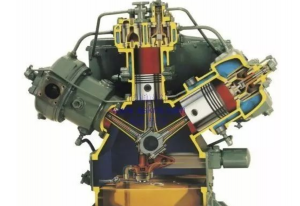1. Phänomen vum festgeklemmte Zylinder
Definitioun vum festgeklemmte Kompressorzylinder: Dëst bezitt sech op de Phänomen, datt déi relativ bewegend Deeler vum Kompressor wéinst schlechter Schmierung, Ongereimtheeten an aner Grënn net funktionéiere kënnen. E festgeklemmte Kompressorzylinder weist op, datt de Kompressor beschiedegt ass. E festgeklemmte Kompressorzylinder trëtt meeschtens op der relativer Gleitlager- a Kurbelwellenreibungsfläch, dem Zylinder an dem ënneschte Lager, an der relativer Rollreibungsfläch vum Kolben an der Zylinderreibungsfläch op.
Feelerbeurdeelung als Zylinderblockéierungsphänomen (Kompressorstartfehler): Dat heescht, datt den Startdrehmoment vum Kompressor de Systemwidderstand net iwwerwanne kann an de Kompressor net normal ufänke kann. Wann sech déi extern Konditioune änneren, kann de Kompressor ufänke, an de Kompressor ass net beschiedegt.
Konditioune fir den normale Start vum Kompressor: Startmoment vum Kompressor > Reibungswiderstand + Héich- a Nidderdrockkraaft + Rotatiounsträchheet Reibungswiderstand: Et hänkt mat der Reibung tëscht dem ieweschten, ënneschten Lager, dem Zylinder, der Kurbelwell an der Viskositéit vum Kältemëttelueleg vum Kompressor zesummen.
Héich- an Nidderdrockkraaft: am Zesummenhang mam Gläichgewiicht tëscht héijen an niddregen Drock am System.
Rotatiounsträchheet: a Bezuch op Rotor- an Zylinderdesign.

2. Heefeg Ursaache fir Zylinderverschleppungen
1. De Grond vum Kompressor selwer
De Kompressor ass schlecht veraarbecht, an d'lokal Kraaft op der Konversiounsfläch ass ongläichméisseg, oder d'Veraarbechtungstechnologie ass net raisonnabel, an Ongereimtheeten kommen während der Produktioun an de Kompressor eran. Dës Situatioun trëtt bei Markenkompressoren selten op.
Adaptabilitéit vu Kompressoren a Systemer: Waassererhëtzer vu Wärmepompelen ginn op Basis vu Klimaanlagen entwéckelt, dofir benotzen déi meescht Wärmepompelhersteller weiderhin Klimaanlagkompressoren. Déi national Norm fir Klimaanlagen erfuerdert eng maximal Temperatur vun 43°C, dat heescht, déi maximal Temperatur op der Kondensatiounssäit ass 43°C ℃, dat heescht, d'Temperatur op der Kondensatiounssäit ass 55 ℃. Bei dëser Temperatur ass den maximalen Auspuffdrock am Allgemengen 25 kg/cm2. Wann d'Ëmfeldtemperatur op der Verdampfungssäit 43 ℃ ass, ass den Auspuffdrock am Allgemengen ongeféier 27 kg/cm2. Dëst mécht de Kompressor dacks an engem Zoustand mat héijer Belaaschtung.
D'Aarbecht ënner héijer Belaaschtung kann einfach zu enger Verkuelung vum Kältemëttelueleg féieren, wat zu enger net genuch Schmierung vum Kompressor an dem Blockéiere vum Zylinder féiert. An de leschten zwee Joer gouf e spezielle Kompressor fir Wärmepompelen entwéckelt. Duerch d'Optimiséierung an d'Upassung vun internen Strukturen, wéi intern Uelegrécklaflächer an Oflaflächer, sinn d'Aarbechtsbedingunge vum Kompressor a vun der Wärmepompel méi gëeegent.
2. Ursaache vu Kollisiounen, wéi Transport an Handhabung
De Kompressor ass en Präzisiounsinstrument, an de Pompelkierper ass präzis ofgestëmmt. D'Kollisioun an déi staark Vibratiounen beim Transport an dem Transport verursaachen, datt d'Gréisst vum Pompelkierper vum Kompressor sech ännert. Wann de Kompressor gestart oder leeft, dréckt d'Kurbelwell de Kolben an eng bestëmmt Positioun. De Widderstand klëmmt däitlech a bleift schliisslech hänken. Dofir soll de Kompressor virsiichteg behandelt ginn, vun der Fabréck iwwer d'Montage an den Host, vun der Lagerung vum Host bis zum Transport an den Agent, a vum Agent bis bei d'Installatioun beim Benotzer, fir ze vermeiden, datt de Kompressor beschiedegt gëtt. Bei Kollisioun, Ëmkippen, Ligen, asw., laut de jeeweilege Reglementer vum Kompressorhersteller, däerf d'Handhabungsneigung net méi wéi 30° sinn.
3. Grënn fir d'Installatioun an d'Benotzung
Fir d'Klimaanlagen- a Wärmepompelindustrie gëtt et e Sproch vun dräi Punkte fir Qualitéit a siwe Punkte fir Installatioun. Och wann et iwwerdriwwen ass, ass et genuch fir ze weisen, datt d'Installatioun e groussen Impakt op d'Benotzung vum Host huet. Leckagen, etc. beaflossen d'Benotzung vum Host. Loosst eis se een nom aneren erklären.
Niveautest: De Kompressorhersteller bestëmmt, datt d'Laafneigung vum Kompressor manner wéi 5 soll sinn, an d'Haaptunitéit horizontal installéiert soll ginn, an d'Neigung soll manner wéi 5 sinn. Laangfristeg Operatioun mat enger offensichtlecher Neigung wäert eng ongläichméisseg lokal Kraaft an eng grouss lokal Reibung verursaachen.
Evakuéierung: Eng ze laang Entleerzäit féiert zu engem Mangel u Kältemëttel, dem Kompressor net genuch Kältemëttel fir ze killen, der Auspufftemperatur gëtt héich, dem Kältemëttelueleg gëtt karboniséiert a verschlechtert, an dem Kompressor bleift wéinst net genuch Schmierung hänken. Wann Loft am System ass, ass d'Loft en net kondenséierbart Gas, wat zu héijem Drock oder anormalen Schwankungen féiere kann, an d'Liewensdauer vum Kompressor beaflosst gëtt. Dofir muss en beim Entleern präzis no de Standardufuerderunge geleet ginn.
Zäitpunkt vun der Verëffentlechung: 11. Februar 2023




